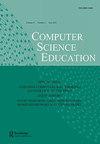Characterizing changes in teacher practice and values through co-design and implementation of computational thinking integrated biology units
IF 2.2
Q1 EDUCATION & EDUCATIONAL RESEARCH
引用次数: 0
Abstract
ABSTRACTBackground and Context To better reflect the computational nature of STEM disciplines and deepen learning of science content computational thinking (CT) should be integrated in science curricula. Teachers have a critical role in supporting effective student learning with CT integrated curricula in classroom settings.Objective Our team worked with high school teachers to co-design and implement CT-integrated biology units.Method We use a model of professional growth and qualitative case studies to characterize changes in teacher practice and values through their involvement in co-design and implementation of a CT-integrated biology unit.Findings Teachers followed similar pathways of professional growth, but their participation and perceptions varied, resulting in three dimensions: 1) participation during design, 2) participation in co-design during implementation, and 3) perception of CT benefits related to student learning.Implications It is important to support teacher comfort and engagement in the co-design process in order to better facilitate professional growth and CT integration.KEYWORDS: Computational thinkingprofessional growthco-designsecondary teachersprofessional developmentin-service teachers AcknowledgmentsThis work was made possible through generous support from the National Science Foundation (grants DRL-1640201 and DRL-1842374) and the Spencer Foundation (Award #201600069). Any opinions, findings, or recommendations expressed in this material are those of the author(s) and do not necessarily reflect the views of the funding organizations.Disclosure statementNo potential conflict of interest was reported by the author(s).Notes1. https://en.wikipedia.org/wiki/Hardy–Weinberg_principle2. https://www.hhmi.org/biointeractive/making-fittest-natural-selection-and-adaptationAdditional informationFundingThis work was supported by the National Science Foundation [DRL-1640201 and DRL-1842374]; Spencer Foundation [201600069].通过计算思维整合生物单元的共同设计与实施来描述教师实践与价值观的变化
摘要背景与背景为了更好地体现STEM学科的计算性,深化科学内容的学习,应将计算思维(computational thinking, CT)融入科学课程。教师在课堂环境中支持学生通过CT综合课程有效学习方面发挥着关键作用。目的本研究小组与高中教师合作,共同设计和实施ct集成生物单元。方法我们使用专业成长模型和定性案例研究来描述教师实践和价值观的变化,通过他们参与共同设计和实施ct集成生物单元。教师遵循相似的专业成长路径,但他们的参与和感知不同,导致三个维度:1)参与设计,2)参与共同设计实施,以及3)感知与学生学习相关的CT益处。为了更好地促进专业成长和CT整合,在协同设计过程中支持教师的舒适和参与是很重要的。本研究得到了美国国家科学基金会(拨款DRL-1640201和DRL-1842374)和斯宾塞基金会(奖励#201600069)的慷慨支持。本材料中表达的任何意见、发现或建议均为作者的意见,并不一定反映资助组织的观点。披露声明作者未报告潜在的利益冲突。https://en.wikipedia.org/wiki/Hardy-Weinberg_principle2。本文由国家自然科学基金资助[DRL-1640201和DRL-1842374];斯宾塞基金会[201600069]。
本文章由计算机程序翻译,如有差异,请以英文原文为准。
求助全文
约1分钟内获得全文
求助全文
来源期刊

Computer Science Education
EDUCATION & EDUCATIONAL RESEARCH-
CiteScore
6.90
自引率
3.70%
发文量
23
期刊介绍:
Computer Science Education publishes high-quality papers with a specific focus on teaching and learning within the computing discipline. The journal seeks novel contributions that are accessible and of interest to researchers and practitioners alike. We invite work with learners of all ages and across both classroom and out-of-classroom learning contexts.
 求助内容:
求助内容: 应助结果提醒方式:
应助结果提醒方式:


